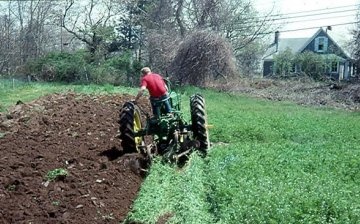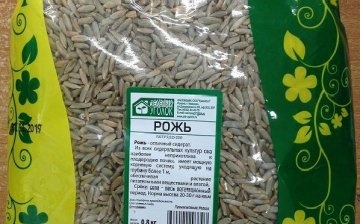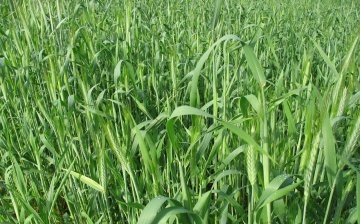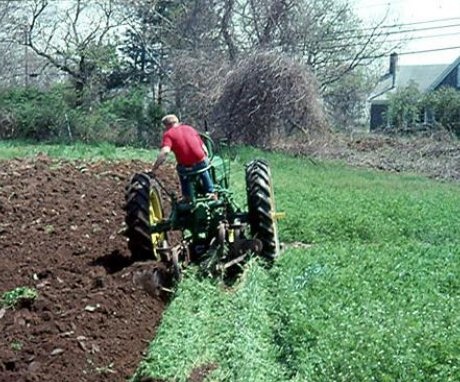Why rye is good as a siderat in autumn and how to use it correctly
Siderata are plants that help improve the condition of the soil and increase fertility. In addition, their use significantly reduces the number of weeds and harmful insects without the use of chemical compounds.
All green manure plants are distinguished by their ability to quickly build up green mass, which, when mowed, quickly decomposes and saturates the upper layers of the soil with nutrients.
Using rye as a green manure
Rye in this regard is one of the most popular crops. The plant tolerates frost well, grows quickly and requires almost no maintenance (except that regular watering in extreme heat). Thanks to a well-developed root system, even the most resistant weeds (bindweed, quinoa) survive from the beds, and aerate the soil.
The same roots, which can reach a length of 1.5 - 2 meters, raise useful minerals to the soil surface, including hardly soluble phosphates.
Not demanding on the composition of the soil. It grows both on heavy, clayey soils and on sandy soils. Greens can be used as a base for compost. It quickly decomposes (on average in 40-60 days), saturating the soil with potassium and nitrogen, which is necessary for the development and growth of almost all garden and horticultural crops.
Moreover, unlike alfalfa or rapeseed, it does not need to be mowed or chopped. In the spring, the remaining half-decayed stems and roots can simply be dug up as in conventional tillage.
Advantages:
The main advantage is cheap seeds, simple sowing without preliminary soil preparation, and also:
- The ability to use in any region. Rye calmly tolerates low temperatures up to -20 degrees, is not demanding on the composition of the soil.
- It grows quickly - during the summer, the greens are mowed 3 times. Subsequently, they are used as mulch or sent to compost.
- Perfectly loosens the soil.
- Prevents weeds from growing.
- Prevents soil freezing, traps snow.
- Protects and rid the soil of nematodes and harmful bacteria.
In addition, rye improves the composition and structure of the soil, reduces the acidity of the soil.
Flaws:
- Due to the nature of the root system, it needs regular watering. And since the root system is sufficiently developed, it can dry out the top layer of the earth.
- You should not sow rye in small areas - it is quite problematic to cope with a powerful root system using an ordinary shovel.
- When used on poor soils without organic fertilizers, it will not work to increase soil fertility. The seeds will "pull" the last nutrients out of the ground.
Tip: Don't plant rye next to fruit trees and bushes. This is especially true for young seedlings. Growing up rye will pick up moisture and nutrients from the soil. For 6-7 year old trees, it is possible to use green manure. But it is better to plant them at a distance of 0.5 - 1.5 m. In order not to damage the roots of trees during the subsequent embedding into the soil.
For what crops is it suitable
Since few people grow cereals in their gardens, the risk of cross transmission of rye diseases to garden crops is excluded. Therefore, rye, as a precursor, can be used for tomato, cucumbers, zucchini, beans and berries - strawberries, raspberries.
Many gardeners use rye as green manure before planting potatoes. There are advantages to this, but the roots of rye - the wireworm loves - is the worst enemy of potatoes.Therefore, when preparing the soil, it is better to use a mixture of rye and mustard seeds.
But rye is not suitable as a siderat for further sowing of any cereals (including decorative ones).
What benefit will it bring
In addition to aerating properties, the roots of rye secrete the toxic substance colin, which inhibits the vital activity of pathogenic bacteria, but is absolutely safe for plants.
Increases the concentration of potassium in the topsoil. They prevent the soil from freezing, therefore, rye is often sown under fruit and berry crops to protect the roots from freezing.
When planted in wetlands, it dries up the soil.
It can be used for weed control, for example, if the land has not been cultivated for a long time. In this case, for better growth and development, it is not bad to add nitrogen fertilizers to the soil before planting.
Advice: when using green manure, it is better to carry out several crops per season. In this case, use the seeds of different plants. For example, sow lupine or mustard in the spring, and rye in the fall.
When is the best time to sow
Landing time depends on the region and climate. For example, for central Russia, this is the period from late August to mid-September. For the southern regions - until the end of October. For the northern ones - until the end of August.
If you plan to use rye as fertilizer, you need to choose planting dates so that the grains have time to germinate and form a root system. This takes about 30-45 days. After that, the regrown green shoots will calmly overwinter under the snow, and in early spring at a stable temperature of + 2-3 degrees, they will continue to grow actively.
Winter rye can also be planted in late October and early November before the onset of persistent frosts and freezing of the soil. In this case, seedlings will appear in early spring.
How to plant rye as a siderat
The seeds can be purchased at any store. The only condition is that it is better to choose grains that have been aged for at least 1 year and, preferably, small grain varieties. They are more frost-resistant and have better germination.
There is no particular need for any soil preparation before sowing. In the spring, the bed will still have to be dug up. It is enough just to loosen the top layer with a rake. Consumption - 1.5 / 2 kg of seeds per hundred square meters of land.
Seeds are sown in rows (in prepared grooves up to 5 cm deep) or evenly scattered on the soil surface. The planting depth is on average 3 cm, for clay and heavy ones - 1.5 cm, so that it is easier for the grain to sprout. For convenience, so as not to sprinkle the seeds by hand. You can use the same rake or flat cutter.
Tip: the dry soil should be well watered before sowing.
Many summer residents advise leaving the grains on the surface, without mulching. This is not entirely correct, since there is a risk that the seeds will be destroyed by birds.
How to care
Crops do not require special care. In dry weather, seedlings should be watered regularly. If the August crops have sprung up and grown by 25-30 cm, they need to be cut. Otherwise, the stems and leaves will become coarse, they will rot for a longer time. And if you miss the moment and let the ears ripen, then the rye will turn into a malicious weed, which will be very difficult to exterminate. Firstly, digging up the soil and removing powerful roots is hard work, and secondly, ripe grains will attract rodents to the site.
In the spring, the grown greens are mowed. In order for it to decompose faster, the soil needs to be moist. If the winter was little snow, and the spring is dry and warm, the earth will have to be thoroughly shed with water. To accelerate the decomposition, you can also use special EM preparations (for example, Baikal).
Otherwise, the green mass will simply rot, with all the ensuing negative factors - the reproduction of putrefactive bacteria and fungi.
Digging
Agronomists have different opinions about digging. On the one hand, digging allows you to improve aeration of heavy soil, "deliver" nutrients to deeper layers of the soil.At the same time, supporters of no-till farming argue that digging green manure is a violation of the ecological balance of the soil. When soil layers move, most of the beneficial microorganisms are lost, and erosion processes are aggravated.
When using the second method, the greens mown in spring are scattered on the surface of the beds, if necessary, watered with water, and after a couple of weeks, the soil is slightly loosened and vegetables are planted.
Many experienced gardeners note that when using the no-till method, the structure of the soil really becomes better, and the fertile layer becomes thicker.
Features of the use of rye as greenhouse greenhouse
Greenhouse soil is different from open ground. It is depleted faster, and due to high humidity, harmful bacteria develop in it much faster. Rye planted in a greenhouse will not only help improve the composition of the soil, but also get rid of fungal infections and mold.
Sowing technology is practically no different from open ground:
- you need to loosen and level the ground;
- densely cover the surface with seeds;
- lightly sprinkle with earth and compost - you can use the flat side of the rake, rolling the grains into the soil;
- water well;
- after 14 days, seedlings can be planted.
The first shoots will appear in 10 days. As soon as the shoots grow 20-30 cm, they must be cut off and watered abundantly in order to speed up the decomposition process. You don't need to dig up anything. In the spring, it is enough to cover the beds with a layer of compost.
Reviews of gardeners
Here are some reviews of gardeners about the advantages and disadvantages of using rye as a green manure
- Tatiana, Bryansk
“I read rave reviews, sowed a plot for potatoes in autumn. I didn't dig anything up in the spring. I just cut the greens and left them on the field. The spring was rainy, so there was no need to water. When the potatoes were planted, it seemed that the soil really became lighter or something. I don’t know about the yield, I did not notice any special changes. I will try to sow again in the fall. "
- Vyacheslav, Korolev
“We sow rye every year. First sowing in August. Do not cut the greens. And we dig up the ground. As a result, they end up under a layer of soil and turn into humus until spring. We immediately prepare the second batch. We sow the same thickly and this time we leave for the winter. You don't need to dig anything up in the spring. We plant potatoes in open ground, tomatoes, cucumbers - in a greenhouse. Everything is fine. The harvest is always excellent. "
- Elena, Perm
“I tried to plant rye on the site (recently bought, the land is neglected, a lot of weeds). In the spring, I didn’t dig up anything, didn’t cut it, I just mowed the young "tops". Weeds have really decreased. I will try to sow again closer to autumn ”.
Winter rye, like green manure, is an excellent choice for heavy and wet soils. Improves aeration and "dries up the soil". Rye can also be used if the site is located in a lowland - the earth will dry out faster in spring.
Related videos:












I have never sowed green manure for soil preparation for vegetable crops and weed control. Next year I will definitely sow rye before winter. If the harvest of garden crops is greater, then I will periodically sow rye in the fall.
There is not enough time to plant green manures in autumn, although the idea is certainly reasonable, and if the farm has poultry or a cow, then there will be no questions about what to do with such beds in the spring.
I use rye as a siderat in late autumn, when nothing else can be sown. I just put it in the top layer without digging. Yes, I also tried winter rape - I didn't like it. This year I also planted it on a part of the site. Recently I was at the dacha, there is a "greenish brush" (little snow) of 7-8 centimeters, maximum 10. In the spring I will just dig up before planting other crops.
After sowing rye, tomatoes, potatoes, melons and cucumbers grow well in my garden. It is especially good to plant it in areas where wheatgrass has spread. It suppresses it and other weeds very well. After mowing the greenery, all that remains is to dig up the ground to get rid of the wheatgrass roots completely. They say that rye and wheat attract wireworms to the site, but I have not noticed this yet. Nobody has had this after rye?